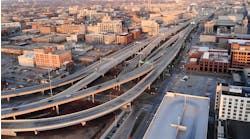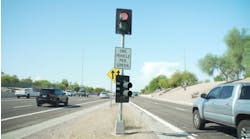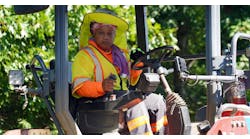By: Jenni Prokopy
The accident was massive and consuming. On Saturday, Oct. 13, a pileup in a southbound truck bypass tunnel at the intersection of I-5 (Golden State Freeway) and California 14 (Antelope Valley Freeway) in Santa Clarita, about 20 miles north of Los Angeles, caused a chain reaction. By the time it was over, 31 vehicles were involved, resulting in three deaths and 10 injuries. A massive fire burned for hours and it took firefighters, California Highway Patrol and Caltrans personnel 52 hours to restore traffic on the I-5 north- and southbound mainline freeway lanes as well as the northbound truck bypass lanes.
“It was medieval,” said Ron Federico, executive vice president of Superior Gunite, a subcontractor on the project. “There were truck tires, batteries, seats . . . melted to ash. It was emotional for me to look at it when I saw it the first time. The feeling you got walking through there . . . the heat was so intense, concrete had spalled off the walls, concrete on the ground had exploded 6 in. deep.”
In the aftermath of the accident, it was clear to Caltrans officials that extensive work would be needed to repair the I-5 truck bypass tunnel, and it would have to happen quickly. According to Tom Pyle, chief of the Office of Rigid Pavement Materials and Structural Concrete for Caltrans, “The interior of the tunnel was over 1,100 °F for many hours. There was severe damage to the concrete in the tunnel due to heat and soot.”
Once crews entered the tunnel on Oct. 15 and reviewed the damage, they agreed the pavement would have to be completely replaced and the walls repaired; in some places the walls sustained damage a few inches deep. Parts of the ceiling could be retained or repaired, and others needed replacement. “A lot of the damage came because as the concrete heated and the fire crews sprayed water in, it caused the concrete to spall,” said Pyle.
The need for speed
Caltrans began the bidding process almost immediately. An engineering evaluation was completed around Oct. 19, and on Oct. 27 Caltrans hosted a bidder walk-through, accepting a handful of bids and solidifying the project strategy. On Oct. 29 Security Paving Co. Inc. of Sun Valley, Calif., won the job and work began—with a vengeance.
The 33-day contract was to start at 12:01 a.m., but Security Paving crews jumped the gun by a few hours. “Within hours we were mobilizing, and we had 25 guys working that night,” said Mike Mattivi, vice president and superintendent for the project. The next morning, a meeting of all the subcontractors ensured everyone was on the same page.
There was an intense urgency to the project, he explained, because in addition to the $11 million contract, an incentive/disincentive clause could result in a $2.9 million bonus for completion on or before Nov. 15—or a $150,000 penalty for each late day. The work was complicated by the confined quarters and the high number of staff needed at any given moment to stay on schedule; at times, there were 200 or more personnel working simultaneously on-site.
Demolition was first on the agenda, and Mattivi said they attacked it immediately. “It took us 20 hours of demo exactly, with 20 trucks hauling to the dump site,” he said, to remove about 24 in. of fire-damaged concrete pavement and sub-base material.
Designing a brighter, whiter tunnel
While demolition proceeded, final details of the mix designs were determined and plans made for material procurement and staging. Caltrans decided to try a new approach with a material it had never before specified in paving and tunnel lining: white cement concrete.
“We were looking for a maintenance-free surface that can be cleaned easily and provides enhanced visibility for safety and less energy requirements for lighting,” said Pyle. “We considered using paint, but it has a limited life and degrades over time, particularly when washed with high-pressure water blasting. Concrete made with white cement is expected to last the entire life of the tunnel.”
John Aube, technical sales representative for Lehigh White Cement, said white cement concrete definitely solves all the issues Caltrans was looking to address. White cement concrete is brighter because it possesses a higher albedo rating, a number from 0 to 1 that indicates the amount of reflectivity. “Asphalt pavement may have an albedo of 0.1, absorbing most light,” he explained. “Gray concrete may have 0.3 to 0.4, and white cement concrete has 0.7 to 0.8—it reflects double the light of gray concrete.”
On the maintenance side, the concrete material is easy to pressure clean with water, which is much faster than bringing in painters, shutting down lanes and endangering their safety so they can recoat tunnel walls and ceilings.
Superfast shotcrete
Before pavement placement, the walls and ceiling of the tunnel needed to be tackled. Demolition involved chipping back the walls and water-blasting to remove the damaged concrete, said Pyle; about 3 to 4 in. were removed (the walls were 18 to 22 in. thick). The first 90 ft of the tunnel (nearest the site of the accident) were replaced entirely, while the rest were cleaned with a high-pressure washer and left in place.
Federico said he, too, felt the pressure to beat the project deadline. While his contractual start date for shotcrete work was Nov. 5, his team started working on Oct. 29; they needed 96 hours to produce test panels for three different materials. He brought in a massive crew, at one point using as many as 148 workers in the tunnel. They worked 20-hour days for three days in a row, cutting their contract time in half. “We had to have all of the tunnel lining done by Nov. 6 . . . Mike [Mattivi] needed seven days to do the pavement,” he said.
The first layer Federico’s team placed was a 4,000-psi ready-mixed shotcrete material designed to replace all the damaged concrete. A specialty bagged, high-strength, noncorrosive material also was used to patch areas with deeper damage; crews chipped out the worst areas by hand.
Then it was time to coat the entire tunnel area—27,000 sq ft—with refractory shotcrete tunnel lining. E-Z Mix Inc. of Rialto, Calif., came on board to supply a specialty mix incorporating white cement for reflectivity and durability. David Adams, technical representative for the company, explained that procuring some raw materials was tough.
The mix included a blend of 50% ground granulated blast furnace slag (GGBFS) and 50% white cement, plus silica sand—not the easiest component to find in Southern California. However, supplier P.W. Gillibrand in Simi Valley, Calif., came through. “With all the stucco going on, it’s hard to get our hands on the material,” he said. “I can’t get a load a week for our personal use, but they got me 16 loads in two days.”
“It was a fun project to work on,” said Adams. “It was consuming. I thought we had a week to gather materials to get this thing going, and we ended up shipping the materials in two days—we had 15 trucks on the job within 14 hours.”
Pavement: Strength and beauty
The pavement concrete mix also was unique in a variety of aspects, said Boris Stein, vice president of materials engineering and research at Twining Laboratories of Southern California Inc. His firm consulted with National Ready Mixed Concrete Co. of Encino, Calif., to create the mix design.
In addition to color specifications, Caltrans had stringent strength requirements for the pavement. Typically, explained Pyle, the agency looks for 550-psi flexural strength in 10 days; this time, they wanted it within 24 hours (and a 650-psi flexural strength in seven days). This was in large part because the pacing of the project required equipment to move through the tunnel at a near-continuous pace.
The resulting mix, Stein said, contained Type I white cement, plus five admixtures, one mineral and four chemicals. Metakaolin, the mineral admixture, has a white color and is typically included to improve the durability of concrete. A superplasticizer was used to provide workability and reduce the water-to-cement ratio; an accelerator of hardening in high quantity helped provide high early strength; a shrinkage reducing admixture limited drying shrinkage; and a hydration stabilizer was used to provide sufficient time for the mix to remain workable.
Allen Ellis, vice president of operations for National Ready Mixed, said that although the original goal was to bring high-grade white aggregates from another area of the state, the team chose local aggregates instead, so the final concrete mix isn’t pure white. “In other cases, to get it pure white you need to use white sand and white aggregate,” he explained. For example, white driveways use a pure white mix, but once cars drive on them they appear dirty quickly. “A compromise is using local aggregates that aren’t pure white, but still give a good level of reflectivity.” The concrete is still extremely light, he said. “We had to paint white stripes, and then black stripes on either side to make them stand out.”
As with every other aspect of the job, pavement placement was quick. Mattivi said the low clearance in the tunnel limited equipment options, so a Texas screed was used to place the lean concrete first 8 in. thick. The concrete was so fast-setting he had 15 to 20 men finishing behind the screed, hand-floating it with a rough finish. Two 12-hour shifts did the job.
The final layer of concrete—four 12-ft-wide lanes—were placed with a Whiteman roller screed. Again, the finishing window was tiny, so a crew of six or so men followed the roller screed for finishing, and that portion was completed in 32 hours. A final pass of profile grinding on the surface took an additional 15 hours.
Speed, teamwork and a strong spirit
In the end, the intensity paid off, and the project was completed and opened on Nov. 15, earning Security Paving the maximum bonus. Pyle said Caltrans is thrilled with the results: “There was absolutely no compromising the strength requirements—we got the strength we were looking for,” he said.
“Did we get the white surface we were looking for? Yes. It was even better than we expected. The current tunnel is very white,” Pyle added. “The white cement works in tandem with the lights to improve the visibility. The walls are brilliant and have a smooth troweled finish. The pavement is also very bright, but it was ground for smoothness, so there is a large portion of aggregate that is visible also, which takes a little of the whiteness away. But I wanted to see how it would look when ground for smoothness, and it turned out very white. We are less concerned with the pavement because it will get dirty from the traffic, but it has started out very white.”
Nearly everyone marvels at the speed and success with which the project was completed. “You name a piece of equipment, we were all in there at the same time,” said Ellis, emphasizing how crowded the tunnel was. “Everyone worked together, and no one was pushing and saying, ‘Hey, get out of my way.’ There were many sleepless nights for everyone.” Stein seconded that opinion, saying that Caltrans also was a full team player, with staff available 24/7. “Everybody in the whole Caltrans group was really awesome,” he said.
It’s clear that for Mattivi and his company, the project was a career-making challenge. “We took something that nobody believed could be done in 16 days, and we did it, to everybody’s surprise,” he said. (In addition to the tunnel work, Superior Paving also repaired 112 linear ft of tunnel deck.) “I really took it on myself. I was there 20 hours a day and slept in a hotel around the corner.” Mattivi is the third generation of his family to work at Security Paving, founded by his grandfather Bruno in 1947 and co-owned by his father, Thomas, and his uncle Albert. “This is a family company, we came a long way—opened people’s eyes that we could tackle a project like this.”
Federico had a similar experience. “The day that it opened, Mike [Mattivi] and I took a picture of both us kneeling in front of it,” he said. “For me, it was really a crowning achievement for my career.” His business is family-owned as well, and he’s worked in it for 20 years.
The accident was tragic, he said. But rebuilding the tunnel was a “beautiful” experience for him and his team. “It erased this terrible scar and put back this beautiful thing—something to really be proud of.”
About The Author: Prokopy is a freelance writer based in Chicago.


